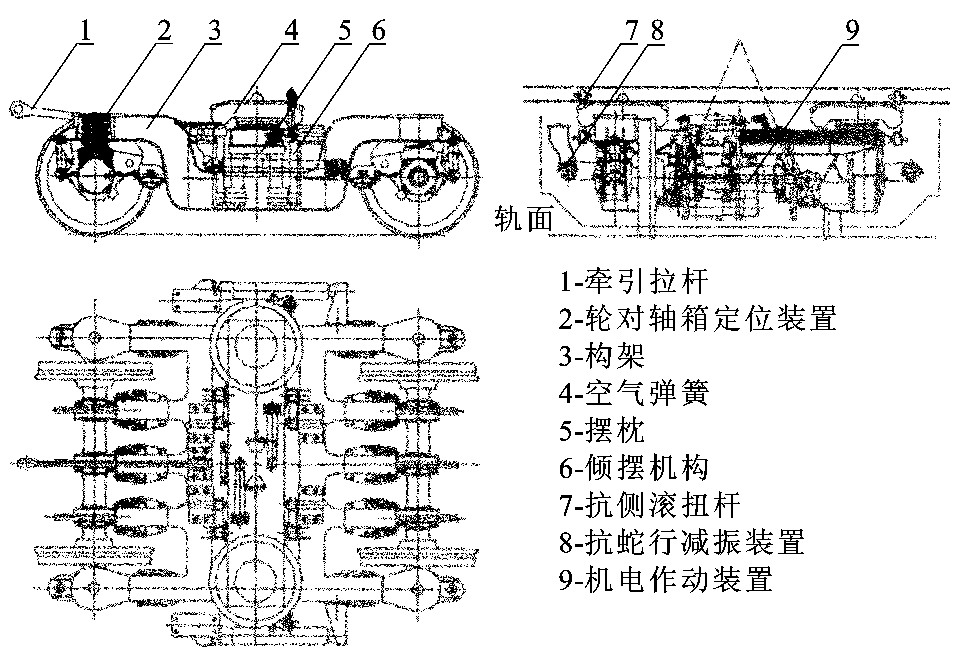Dynamics behaviors of high speed tilting car bogie
-
摘要: 铁路运输欲在竞争激烈的运输市场中占有一席之地, 必须提高其运营速度, 以缩短旅客和货物的运行时间, 旅客列车提速已成为当今中国铁路的一项重大技术政策。采用摆式客车是在既有线路上提速的有效措施, 摆式客车的关键技术之一是转向架。概述了国外几种主要摆式客车转向架的结构特点, 介绍了中国铁道线路的基本情况, 根据中国线路特点和摆式客车对转向架的特殊要求, 提出了以一系柔性定位转向架作为中国高速摆式客车转向架的基本方案, 并对其可行性和必要性进行了分析, 最后对中国高速摆式客车转向架的初步结构和动力学性能进行了探讨Abstract: If the raillway is just going to possess an eminent station in transportation market, it must improve its running speed to shorten the running time of passengers and freights. Today, the improving speed of passenger cars has become an important technology policy of Chinese railway. Adopting the tilting car is an effective measure to improve speed in the existing line. The bogie is one of the key technologies of the tilting car. The characteristic of several kinds of bogies of the tilting car abroad and the basic complexion of Chinese railways is introduced. According to the feature of track and the special demands of tilting car to the bogie, a project that the primary suspension of the bogie for the tilting car is soft, is put forward, and the feasibility and necessity are analyzed. The basic structure and dynamics of the bogie for Chinese tilting cars are discussed.
-
Key words:
- tilting car /
- bogie /
- dynamics
-
表 1 国外几种主要摆式客车转向架参数比较
Table 1. The comparison about the parameters of bogies for the active tilting cars abroad
转向架形式 国别 定位方式 最高速度/km·h-1 轴距/mm 轴重/t 轨距/mm 作动器类型 倾摆机构类型 X2000 瑞典 一系柔性 210 2900 17.0 1435 液压 四吊杆 VT611 德国 自导向 160 2450 14.5 1435 机电 四吊杆 WCML 英国 一系柔性 220 2700 17.0 1435 机电 滚道式 ETR460 意大利 拉杆 250 2700 12.5 1435 液压 四吊杆 283系 日本 迫导向 130 2250 9.0 1067 气动 滚道式 SIG 瑞士 迫导向 220 2600 13.5 1435 液压 四吊杆 表 2 210 km/h摆式客车转向架的主要技术参数
Table 2. The mostly technique parameters of the 210 km/h bogie for tilting cars
最高运营速度/km·h-1 210 轴颈距/mm 2000 最高试验速度/km·h-1 230 空气簧中心横向间距/mm 1900 轴重/t 14.5 空气簧上表面距轨面高/mm 1060 转向架自重/t 7.5 倾摆机构最大倾摆角 ±8° 车轮踏面型式 LMa 倾摆机构最大倾摆角速度 5°/s 车轮直径/mm Φ915 车体摆心高/mm 1570 转向架轴距/mm 2500 车体重心高/mm 1610 限界: 倾摆8°后应满足GB 146.1-94《标准轨距铁路机车车辆限界》要求 -
[1] 李芾. 国外摆式列车发展及运用概况[J]. 西南交通大学学报, 2000, 35(6): 569-575. doi: 10.3969/j.issn.0258-2724.2000.06.001LI Fu. Development and application of tilting trains abroad [J]. Journal of Southwest Jiaotong University, 2000, 35(6): 569-575. (in Chinese) doi: 10.3969/j.issn.0258-2724.2000.06.001 [2] 李芾, 傅茂海, 倪文波. 摆式列车及其相关技术[J]. 交通运输工程学报, 2002, 1(4): 9-14. doi: 10.3321/j.issn:1671-1637.2001.04.002LI Fu, FU Mao-hai, NI Wen-bao. Research on tilting trains and its technology[J]. Journal of Traffic and Transportation Engineering, 2001, 1(4): 9-14. (in Chinese) doi: 10.3321/j.issn:1671-1637.2001.04.002 [3] 傅茂海, 李芾. 摆式客车径向转向架结构及其动力学性能的研究[J]. 铁道车辆, 2002, 40(3): 19-22. doi: 10.3969/j.issn.1002-7602.2002.03.007FU Mao-hai, LI Fu. Research on structure and dynamic performance of tilting passenger car bogie[J]. Rolling Stock, 2002, 40(3): 19-22. (in Chinese) doi: 10.3969/j.issn.1002-7602.2002.03.007 [4] VolkerKottenhahn. 摆式列车倾摆系统比较[J]. 国外铁道车辆, 1995, 32(4): 9-17. https://www.cnki.com.cn/Article/CJFDTOTAL-GWTD504.001.htmVolker Kottenhahn. Comparisonof tilting systems[J]. International Rolling Stock, 1995, 32(4): 9-17. (in Chinese) https://www.cnki.com.cn/Article/CJFDTOTAL-GWTD504.001.htm [5] Okamoto I. Development of new carbody tilt system for speed up of curving[J]. Japanese Railway Engineering, 1993, 31(1): 11-15. [6] Sauer. 具有主动摆动技术的611型内燃动车组[J]. 国外内燃机车, 1997, 6(1): 13-18. https://www.cnki.com.cn/Article/CJFDTOTAL-GWMJ199706004.htmSauer. VT611 DMUwith active tilting system[J]. International Diesel Locomtive, 1997, 6(1): 13-18. (in Chinese) https://www.cnki.com.cn/Article/CJFDTOTAL-GWMJ199706004.htm [7] Hochbruck H. NeiTech-Systeme feur den fernverkehr[J]. Der Eisenbahningenieur, 1994, 45(7): 472-480. [8] Lucas de oriol. Talgo to build 300 km/h prototype[J]. International Railway Journal, 1992, 32(1): 30-32. [9] RATHB. Der komfortzug-ein innovatives neigtechnik-konzept[J]. ZEV-Glas, 1997, 121(5): 320-329. -





 下载:
下载:




